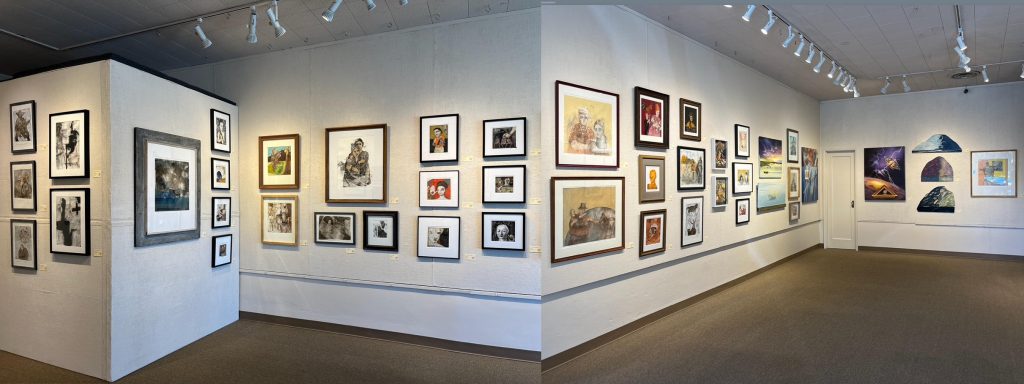Rumi: “We begin by remembering”
is the quote Sally Cloninger told me was the starting point of the group show of five local esteemed, well-loved, and well-seasoned artists who have been part of our Olympia arts community for many years.
Johnathan Happ, Gallery Director of Childhood’s End wanted to show Sally Cloninger’s films which have not been seen by the larger population. He invited Cloninger and Marilyn Frasca, both retired professors at Evergreen, to do a show. They both decided instead to curate a group show of local artists. Cloninger and Frasca considered where people start when they create, the conclusion they came to was that we start with what we remember.
Many of the works were made pre-pandemic pre-wildfire, and pre-climate change, but many are new, and the common thread is what these creative minds produce with the advantage of reflection and time. There is a lot of layering in these artists’ works. What came before is covered by what is now, but what came before is still apparent if you look. It is only when we look back, we can see where we have been and ask ourselves where we are going, a constant editing process that hopefully produces the best in us. This is the strongest apparent keynote that runs throughout the show but as Cloninger says: “There’s a whole range of things, because that’s life.” The gallery is salon-hung. There are no determined borders between the artists’ work, they tolerate each other well and dance to a common theme. The title of the show, “This Old World,” comes from one of Cloninger’s five films, but Cloninger tells me the title only became apparent once the show had been manifested.
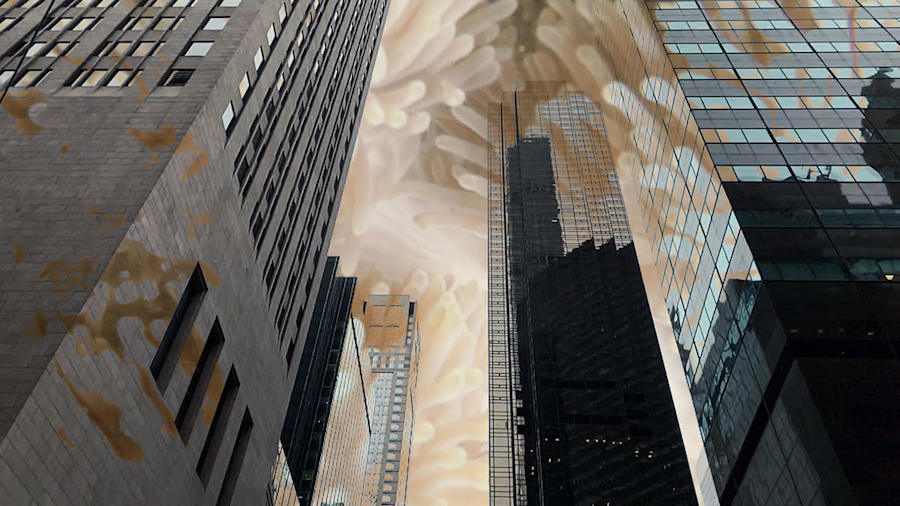
Cloninger is showing five short films, four from her series: Cinema for the Anthropocene. They are: You Decide, While We Sleep, The Unravelling of Time, This Old World. If I Were a Fish is not part of the series, but they work well together or individually. The whole show benefits from viewing these films, so I advise you to see them first. They play in a continuous loop in a booth in the back of the gallery. The visual and sound quality are good, the space is not too small, it is comfortable and gratifyingly free of distractions. Cloninger’s films are so worth the time spent viewing. They are assemblages, fleeting impressions of different worlds juxtaposed with each other, sometimes identifying similarities, while at the same time pointing out huge disconnections between the modern man-made and the natural worlds. In her films, we travel through space and time, skillfully navigated through different cultures, and environments and through the lens of others’ experiences; sometimes up close and personal and at other times whizzed into outer space all accompanied by mesmerizing music. While We Sleep music was composed by Gretchen Langheld. Cloninger composed all other soundtracks and worked sound design throughout. It all has the effect of connecting these things, while at the same time recognizing the vastness that separates our understanding of each other.
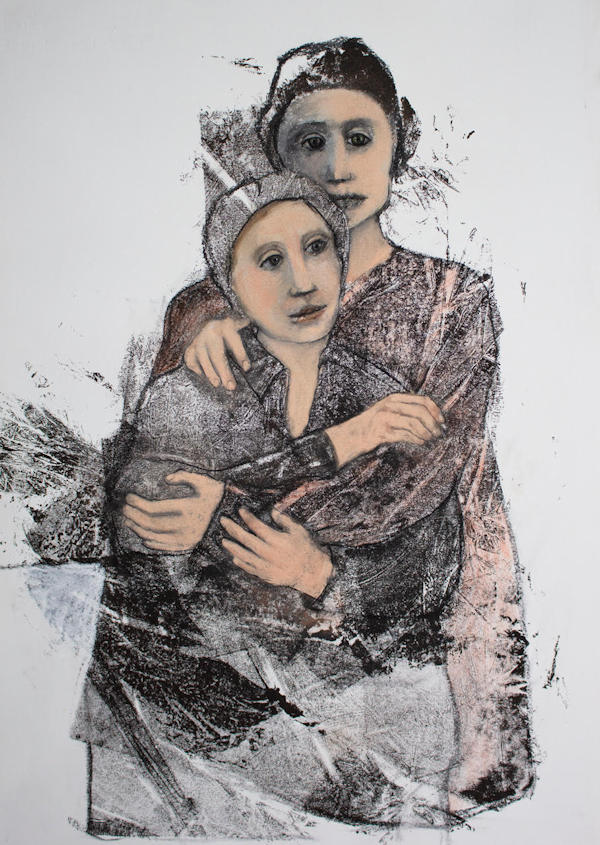
Frasca makes printed monotype textures with layered pastel. She picks out images in these printed textures, the images carry a suggested story, or a social comment coaxed from within. Some are more overt than others. “They-Them” has an image of a spooning couple of indiscernible gender. They’re comfortable in their world, they don’t care what you think. “No Choice” shows a woman cornered by two birds of prey. “And Leaving Home” portrays women with headscarves embracing each other for emotional security. Frasca tells me she was working on this piece when Putin invaded Ukraine. Like the theme of the show, Frasca says it takes time, sometimes days, for these images to surface and reveal themselves to her, she says she never knows what will appear, and often will be surprised by what transpires on the paper. What transpires is a magical fairytale ambiance, with an unflinching empathetic story.
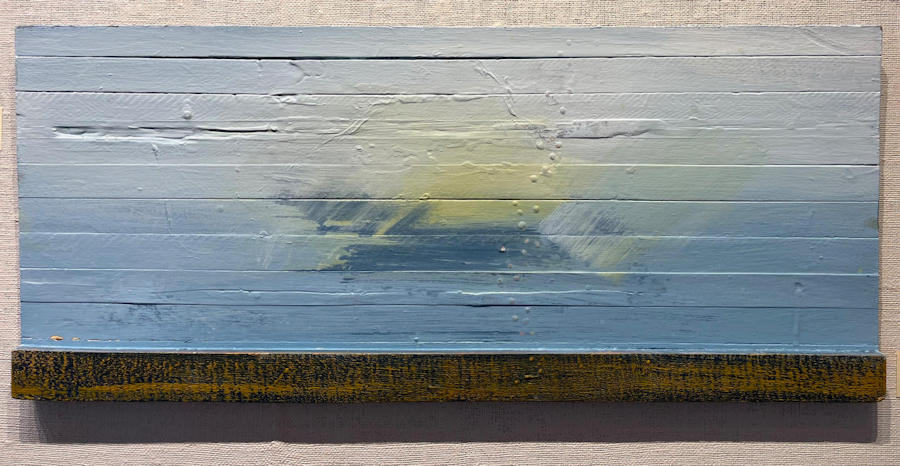
Susan Christian is a much-loved artist and dedicated supporter of the arts. She paints layer over layer of paint often on repurposed lath, which has lived another life as part of a building and is employed to live anew under the layers of Christian’s paints. Her reflections often involve a seascape and a mountain, which should seem timeless enough, but her home was recently flooded by the rising tide, and she was forced to relocate. It makes you wonder how much time was spent looking out of her window, and wondering when exactly that would happen. It happened last year, way sooner than predicted. In her painting “Sparta” the mountain is barely visible, as is the horizon of the sea. Reading this painting as a literal seascape is optional, but if you do, the horizon lines and mountain are blurred but not the ground we stand on.
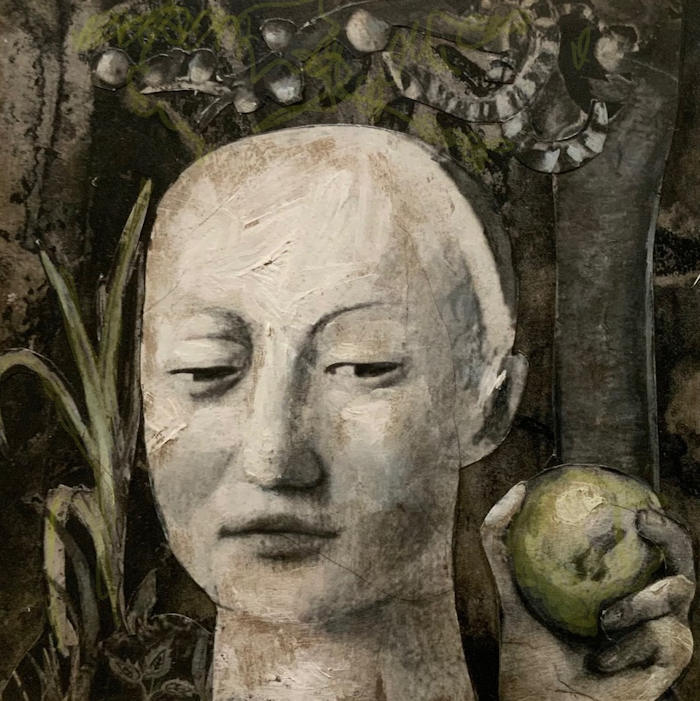
Gail Ramsey Wharton’s art has layers of paint and collage. Her collage images cover a wide range of time periods from Victorian to modern day; she does not discriminate. Her compositions are delivered with a healthy injection of dry humor, like Graffitied, Monty Python-esque, Victorian (or midcentury) diagrams. She reminds me of a visual version of Oscar Wilde, pointing out our common willful absurdities with ready wit. Some of her works are very literal, others not so much; it doesn’t matter, they’re all as charming and as darkly entertaining as you can imagine a graffitied Victorian would be.
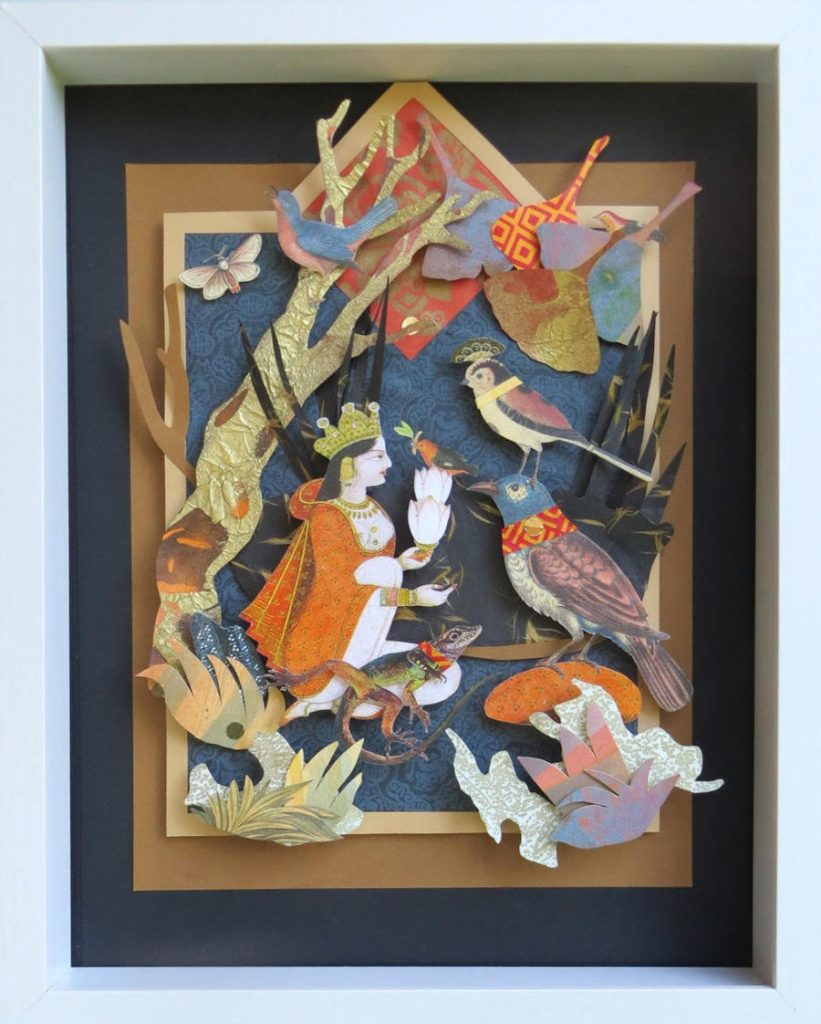
Susan Aurand’s paintings remind me of scrapbooks. Items from the natural world placed carefully together like modern-day icons, she invites us to look anew at things in nature taken for granted in case we forget what is important, or how important. “Trouble in Paradise” shows a giant displaced, upturned bee against a backdrop of the big dipper constellation and a strike of lightning. “Weaving Light” portrays a hummingbird seemingly underwater overlayed with an image of two beetles. Her 3D collages are surreal and allegorical, and like small pop-up books or stage sets. They are layered, partly from Indian illustrations but most are repurposed images she made for other projects and brought out of storage from up to 20 years ago.
This Old World is a show made by artists who have lived a full life, it is eloquent, and expertly executed but is also experimental. The show’s strength and intrigue are the collective time both in creative art practice and lived experience demonstrated by the artists. It is not understated but it is subtle, and it leaves us asking more questions than it answers, making room for our own reflections on our personal life journey, and collective journey as a species.
WHAT
Art exhibition This Old World
WHEN
10 a.m. to 6 p.m. Monday-Saturday, 11 a.m. to 5 p.m. Sunday, through June 11
WHERE
Childhood’s End Gallery, 222 4th Ave. E, Olympia
LEARN MORE
https://www.childhoods-end-gallery.com/Exhibit.html

